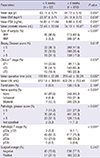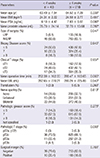1. Jung KW, Won YJ, Kong HJ, Oh CM, Seo HG, Lee JS. Cancer statistics in Korea: incidence, mortality, survival and prevalence in 2010. Cancer Res Treat. 2013; 45:1–14.
2. Stitzenberg KB, Wong YN, Nielsen ME, Egleston BL, Uzzo RG. Trends in radical prostatectomy: centralization, robotics, and access to urologic cancer care. Cancer. 2012; 118:54–62.
3. Walsh PC, Partin AW. Anatomic radical retropubic prostatectomy. In : Wein AJ, Kavoussi LR, Novick AC, Peters CA, Partin AW, editors. Campbell-Walsh Urology. 9th ed. Philadelphia: W. B. Saunders;2007. p. 2956–1978.
4. Lee DK, Allareddy V, O'Donnell MA, Williams RD, Konety BR. Does the interval between prostate biopsy and radical prostatectomy affect the immediate postoperative outcome? BJU Int. 2006; 97:48–50.
5. Eggener SE, Yossepowitch O, Serio AM, Vickers AJ, Scardino PT, Eastham JA. Radical prostatectomy shortly after prostate biopsy does not affect operative difficulty or efficacy. Urology. 2007; 69:1128–1133.
6. Adiyat KT, Murugesan M, Katkoori D, Eldefrawy A, Soloway MS. Total prostatectomy within 6 weeks of a prostate biopsy: is it safe? Int Braz J Urol. 2010; 36:177–181. discussion 82.
7. Martin GL, Nunez RN, Humphreys MD, Martin AD, Ferrigni RG, Andrews PE, Castle EP. Interval from prostate biopsy to robot-assisted radical prostatectomy: effects on perioperative outcomes. BJU Int. 2009; 104:1734–1737.
8. Choi H, Ko YH, Kang SG, Kang SH, Park HS, Cheon J, Patel VR. Biopsy related prostate status does not affect on the clinicopathological outcome of robotic assisted laparoscopic radical prostatectomy. Cancer Res Treat. 2009; 41:205–210.
9. Kim IS, Na W, Nam JS, Oh JJ, Jeong CW, Hong SK, Byun SS, Lee SE. Interval from prostate biopsy to robot-assisted laparoscopic radical prostatectomy (RALP): effects on surgical difficulties. Korean J Urol. 2011; 52:664–668.
10. Epstein JI, Allsbrook WC Jr, Amin MB, Egevad LL. ISUP Grading Committee. The 2005 International Society of Urological Pathology (ISUP) Consensus Conference on Gleason Grading of Prostatic Carcinoma. Am J Surg Pathol. 2005; 29:1228–1242.
11. Okada K, Kojima M, Naya Y, Kamoi K, Yokoyama K, Takamatsu T, Miki T. Correlation of histological inflammation in needle biopsy specimens with serum prostate-specific antigen levels in men with negative biopsy for prostate cancer. Urology. 2000; 55:892–898.
12. Ozden C, Ozdal OL, Guzel O, Han O, Seckin S, Memis A. The correlation between serum prostate specific antigen levels and asymptomatic inflammatory prostatitis. Int Urol Nephrol. 2007; 39:859–863.
13. Oesterling JE, Rice DC, Glenski WJ, Bergstralh EJ. Effect of cystoscopy, prostate biopsy, and transurethral resection of prostate on serum prostate-specific antigen concentration. Urology. 1993; 42:276–282.
14. Li J, Chen J, Kirsner R. Pathophysiology of acute wound healing. Clin Dermatol. 2007; 25:9–18.
15. Krafts KP. Tissue repair: The hidden drama. Organogenesis. 2010; 6:225–233.
16. Reinke JM, Sorg H. Wound repair and regeneration. Eur Surg Res. 2012; 49:35–43.
17. Davey AK, Maher PJ. Surgical adhesions: a timely update, a great challenge for the future. J Minim Invasive Gynecol. 2007; 14:15–22.
18. Nagle A, Ujiki M, Denham W, Murayama K. Laparoscopic adhesiolysis for small bowel obstruction. Am J Surg. 2004; 187:464–470.
19. Farinella E, Cirocchi R, La Mura F, Morelli U, Cattorini L, Delmonaco P, Migliaccio C, De Sol AA, Cozzaglio L, Sciannameo F. Feasibility of laparoscopy for small bowel obstruction. World J Emerg Surg. 2009; 4:3.
20. Dindo D, Schafer M, Muller MK, Clavien PA, Hahnloser D. Laparoscopy for small bowel obstruction: the reason for conversion matters. Surg Endosc. 2010; 24:792–797.
21. Jaffe J, Stakhovsky O, Cathelineau X, Barret E, Vallancien G, Rozet F. Surgical outcomes for men undergoing laparoscopic radical prostatectomy after transurethral resection of the prostate. J Urol. 2007; 178:483–487. discussion 7.
22. Martin AD, Desai PJ, Nunez RN, Martin GL, Andrews PE, Ferrigni RG, Swanson SK, Pacelli A, Castle EP. Does a history of previous surgery or radiation to the prostate affect outcomes of robot-assisted radical prostatectomy? BJU Int. 2009; 103:1696–1698.










